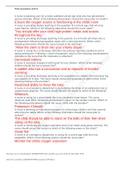NURS1543 EXAM 1 NEWEST 2024 ACTUAL EXAM
QUESTIONS WITH CORRECT VERIFIED ANSWERS
(ALREADY GRADED A+)
5 phases of the nursing process - ANSWER - 1. Assessment
2. Nursing Diagnosis
3. Planning
4. Implementation
5. Evaluation
First-level priority problems - ANSWER - emergent, life-threatening, and immediate,
such as establishing an airway or supporting breathing
Second-level priority problems - ANSWER - those that are next in urgency requiring
your prompt intervention to forestall further deterioration. (mental status change, acute
pain, acute urinary elimination problem, untreated medical problems, abnormal lab test
results)
Third-level priority problems - ANSWER - those that are important to the patient's health
but can be addressed after more urgent health problems are addressed. (Knowledge
deficit, altered family processes, and low self esteem)
Collaborative problems - ANSWER - approach to treatment involves multiple disciplines
Evidence-informed practice - ANSWER - a paradigm and life-long problem solving
approach to clinical decision-making that involves the conscientious use of the best
available evidence (including a systematic search for and critical appraisal of the most
relevant evidence to answer a clinical question) with one's own clinical expertise and
patient values and preferences to improve outcomes for individuals, groups,
communities, and systems
pg. 1
,Health Promotion - ANSWER - "the process of enabling people to increase control over,
and to improve their health. It moves beyond a focus on individual behaviour towards a
wide range of social and environmental interventions." (WHO)
Disparities in health vs. Health Inequities - ANSWER - Disparities in Health occur when
the combination and interaction of the SDoH result in differences in health status
between segments of the population.
When disparities are avoidable but outside the control of individuals, health inequities
result.
Population Health Promotion Model - ANSWER - Multifaceted appraoch to considering
the SDoH in our nursing health assessment.
Culture - ANSWER - No single definition exists. In anthropology, culture is understood
as an inherently complex dimension of people's lives
Ethnicity - ANSWER - complex concept that can encompass multiple different aspects
such as one's country of origin or ancestry, identity, and family history, languages
spoken, and, in some cases, religious identity
ethnic group - ANSWER - a population or group who identify with each other based on a
shared heritage, culture, language, or religious affiliation
visible minority - ANSWER - defined by Statistics Canada as "persons, other than
Aboriginal peoples, who are non-Caucasian in race or non-white in colour," and as
consisting "mainly of the following groups: Chinese, South Asian, Black, Arab, West
Asian, Filipino, Southeast Asian, Latin American, Japanese, and Korean."
Racialization - ANSWER - process of attributing social, economic, or presumed cultural
differences to "race." Racialization may be conscious and deliberate (an act of racism in
which discrimination is overt) or unconscious and unintended. Racism is founded on the
view that there are supposedly biologically real divisions that involve "a hierarchy of
value."
pg. 2
,Discrimination - ANSWER - systemic inequitable treatment of individuals or groups
based on stratified classifications
Cultural Sensitivity - ANSWER - reflects the idea that people have culturally based
understandings, practices, and customs, and that health care providers should be
aware of and accommodate those understandings. Being culturally sensitive can be
useful if it is done in a way that does not stereotype people for the ways in which they
may be different from the dominant cultural norm.
Cultural Competence - ANSWER - "the application of knowledge, skills, attitudes or
personal attributes required by nurses to maximize respectful relationships with diverse
populations of clients and co-workers."
Health Inequality vs Health Inequity - ANSWER - Health inequality is a generic term
used to designate differences, variations, and disparities in the health status of
individuals and groups. An example of health inequality is the higher incidence of deaths
in the prime of life among women in Canada than among men, largely because of
breast and other cancers. Health inequity refers to the inequalities in health that are
unnecessary and avoidable, and differences that are considered unfair and unjust.
Complementary and Alternative Healthcare - ANSWER - umbrella term used to describe
numerous therapies including acupuncture, chiropractic, naturopathy, massage, herbal
medicine, yoga and healing touch
Spirituality - ANSWER - Significant in peoples' health
Communication Skills - ANSWER - Unconditional Positive Regard, Empathy, Active
Listening
closed/direct questions - ANSWER - Questions ask for specific information. They elicit a
short, one or two word answer, a "yes" or "no", or a forced choice.
pg. 3
, open-ended questions - ANSWER - questions that allow respondents to answer
however they want (asks for narrative information)
How to assist the narrative - ANSWER - Facilitation, Silence, Reflection, Empathy,
Clarification, Interpretation, Explanation, Summary
Traps of Interviewing - ANSWER - 1. Providing false assurance or reassurance
2. Giving unwanted advice
3. Using authority
4. Using avoidance language
5. Engaging in distancing
6. Overusing professional jargon or casual language
7. Using leading or biased questions
8. Talking too much
9. Interrupting
10. Using "why" questions
Examples of nonverbal skills - ANSWER - Physical appearance, posture, gestures,
facial expression, eye contact, voice, silence, bodily exposure and touch
Mental Health - ANSWER - capacity to feel, think, express emotions, and behave in
ways that enhance personal capacity to manage challenges, adapt successfully to a
range of demands, and enjoy life.
Mental Wellness (First Nations communities) - ANSWER - supported by factors such as
"culture, language, Elders, families, and creation"25—this concept is linked to inherent
strengths, and positive well-being and functioning. Moreover, it is believed to be
"necessary for healthy individual, family, and community life."
Mental Disorder - ANSWER - Medical term for mental illness and is defined and
diagnosed in Canada according to criteria specified in the Diagnostic and Statistical
pg. 4





